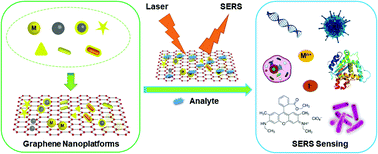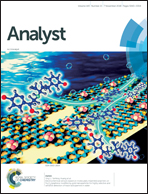Graphene-based nanoplatforms for surface-enhanced Raman scattering sensing
Abstract
Surface-enhanced Raman scattering (SERS) is one of the important techniques for sensing applications in biological analysis, disease diagnosis, environmental science, and food safety. Graphene provides an excellent nanoplatform for SERS sensing due to its two-dimensional flat structure, uniform electronic and photonic properties, excellent mechanical stability, atomic uniformity, and high biocompatibility. In this review, we summarize recent advances in the fabrication of various graphene-based nanoplatforms for SERS sensing. We present the strategies, such as self-assembly, in situ synthesis, one-pot synthesis, liquid phase reduction, and biomimetic synthesis, for the fabrication of graphene-based hybrid metallic and alloy nanoplatforms, and then demonstrate the potential applications of graphene-based nanoplatforms for the SERS sensing of ions, organic dyes, pesticides, bacteria, DNA, proteins, cells, and other chemicals in great detail. In addition, we also discuss the future development of this interesting research field and provide several perspectives. This work will be helpful for readers to understand the fabrication and sensing mechanisms of graphene-based SERS sensing nanoplatforms; meanwhile, it will promote the development of new materials and novel methods for high performance sensing and biosensing applications.

- This article is part of the themed collection: Recent Review Articles


 Please wait while we load your content...
Please wait while we load your content...